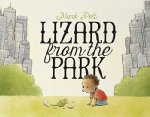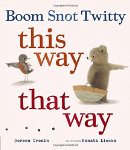All too often, when we don't know what something is, we simply walk away. We can't be bothered to find out. We are too busy doing more 'important' things. In today's picture book readers meet some children who encounter an animal that they cannot identify. They could walk away from, it but they don't. Instead they try to find out what it is and then they do their best to help the animal.
 Sloth Slept On
Sloth Slept On
 Sloth Slept On
Sloth Slept On
Frann Preston-Gannon
Picture Book
For ages 5 to 7
Sterling, 2015, 978-1-4549-1611-6
One day a group of children discover that there is a
strange looking animal in a tree in the backyard. The children ask the animal
its name, and they ask it what it is doing in their tree, but the animal does
not respond at all because it is fast asleep on its branch.
Wanting to know
what the animal is, the children put in in their little red wagon and they “set
off to find some answers.” They ask Dad about the animal but he is too busy to
answer their questions. They look in books to try to find out what their new
friend is, but find nothing. They know what is isn’t, but what it is remains a
mystery. The children even imagine that he might be an astronaut, a pirate or a
knight. Then one of the children makes a discovery, and they learn that that
their new animal friend is very special indeed.
With touches of pictorial
humor throughout her story, the author of this book gives her readers a mystery
that they will enjoy sharing. In the artwork we are given clues to the animal’s
identity, so that, if we are looking hard enough, we know what the animal is
before the children do. This memorable book comes to a close with an ending that
is sure to delight readers young and old.







